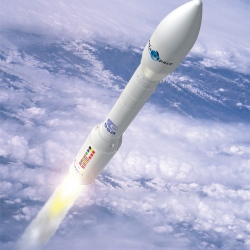
Atomic metallic hydrogen, if metastable at ambient pressure and temperature could be used as the most powerful chemical rocket fuel, as the atoms recombine to form molecular hydrogen. This light-weight high-energy density material would revolutionize rocketry, allowing single-stage rockets to enter orbit and chemically fueled rockets to explore our solar system. To transform solid molecular hydrogen to metallic hydrogen requires extreme high pressures, but has not yet been accomplished in the laboratory. In the proposed new approach electrons will be injected into solid hydrogen with the objective of lowering the critical pressure for transformation. If successful the metastability properties of hydrogen will be studied. This new approach may scale down the pressures needed to produce this potentially revolutionary rocket propellant.
Isaac Silvera is heading up the NIAC project and also co-wrote a 2010 paper on metallic hydrogen rockets
Wigner and Huntington first predicted that pressures of order 25 GPa were required for the transition of solid molecular hydrogen to the atomic metallic phase. Later it was predicted that metallic hydrogen might be a metastable material so that it remains metallic when pressure is released. Experimental pressures achieved on hydrogen have been more than an order of magnitude higher than the predicted transition pressure and yet it remains an insulator. We discuss the applications of metastable metallic hydrogen to rocketry. Metastable metallic hydrogen would be a very light-weight, low volume, powerful rocket propellant. One of the characteristics of a propellant is its specific impulse, Isp . Liquid (molecular) hydrogen-oxygen used in modern rockets has an Isp of ~460s; metallic hydrogen has a theoretical Isp of 1700 s! Detailed analysis shows that such a fuel would allow single-stage rockets to enter into orbit or carry economical payloads to the moon. If pure metallic hydrogen is used as a propellant, the reaction chamber temperature is calculated to be greater than 6000 K, too high for currently known rocket engine materials. By diluting metallic hydrogen with liquid hydrogen or water, the reaction temperature can be reduced, yet there is still a significant performance improvement for the diluted mixture.
